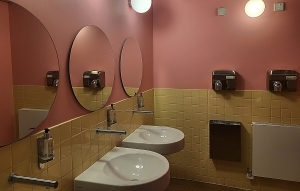Adam Yamey's Blog: YAMEY, page 22
March 5, 2025
A not quite religious experience in a temple in rural Rajasthan
IN DECEMBER 2024, we hired a taxi to take us from Jaisalmer to Bikaner: both are cities in Rajastahan (India). As it was a journey that was going to take over five hours, we decided we needed a break en-route.
When we asked our rather sullen driver to find a place for us to stop for a light lunch, he drove us off the main road into a small town (an overgrown village) called Ramdevra. The modest place where we ate satisfactory vegetarian food was not one frequented by foreign visitors. People hanging around the establishment were clearly curious about us, but in a friendly way. After lunch, our driver encouraged us to walk to the Sree Baba Ramdev Temple, for which the town is famous. It was much further away from the restaurant than the “few minutes” our driver had told us. Near the temple, there were many stalls where lumps of different coloured crystalline dhoop (aromatic products made with herbs and resins, which when heated or burned release fragrant smoke) and incense sticks were for sale. It was very clear that his choosing to stop in Ramdevra was to visit the temple, which turned out to be a crowded place in a huge shed filled with Hindu shrines.

It was mass-production Hinduism. Impatient crowds of people, including us, were hurried along narrow passageways demarcated by metal railings. The maze of railings made the place look like a cattle market filled with animal holding pens. The idea seemed to be to get the devotees to donate money at the several shrines in exchange for blessings that were performed by pandits as quickly as they could manage. Rather than feeling like a spiritual experience, it felt more like being a product on a fast-moving industrial conveyor belt. Our driver seemed pleased that he had visited the temple complex. We did not share his enthusiasm, and were pleased when we returned to the highway.
March 4, 2025
Fascinating paintings by an artist from Japan
THERE IS A SONG by Sam Cooke that begins “Don’t know much about history, don’t know much biology, …”. Well, I do know something about both history and biology, but I do not know much, if anything, about Japanese art history. It turns out that this is not a great impediment if you wish to enjoy an exhibition showing at the Gagosian Gallery in Mayfair’s Grosvenor Hill until 8 March 2025. The visually spectacular show is called “Japanese Art History à la Takashi Murakami”.
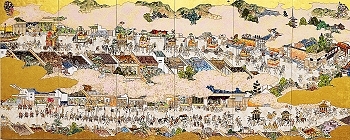
Takashi Murakami was born in 1962 in Tokyo, where he lives and works. Apart from being a painter and a sculptor, he is also, as Wikipedia explained, involved in:
“… commercial media (such as fashion, merchandise, and animation) and is known for blurring the line between high and low arts.”
Many of the paintings in the exhibition at Gagosian are Murakami’s own interpretations of various styles used by Japanese painters in the past. Others gave me the impression of being less historically inspired, but more whimsically contemporary. The exhibition as a whole and in detail is a feast for the eyes. These beautifully executed, often intricately detailed, creations are joyous and uplifting. Maybe, if I knew more about the history of art in Japan, I would have gained even greater enjoyment from seeing them, but in this exhibition, the sentence ‘ignorance is bliss’ is certainly not inapplicable.
March 3, 2025
Dwarfed by dogs in Mayfair’s Dover Street
SOME SAY SMALL is beautiful. But can colossal also be beautiful? This is something that can be explored at the Thaddeus Ropac Gallery in London’s Dover Street until 2 April 2025, where three much larger than life realistic looking sculptures of dogs are on display. These dogs, each about 10 feet high, have been created by the artist Ron Mueck, who was born in Australia in 1958. He now works in the UK.
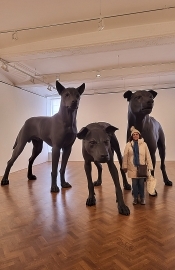
As the gallery’s website explained:
“Over a career spanning three decades, Mueck is celebrated for exploring the physiological implications of scale. Whether miniaturised or enlarged, his use of scale heightens our awareness of the relative spaces our own bodies occupy, as he charts the full spectrum of human experience with striking perceptiveness.”
The three dogs on display in the exhibition ought to feel menacing, but I did not experience this sensation. I was more amused than over-awed.
March 2, 2025
Benjamin Disraeli the Prime Minister lived here
IN 1847 ISAAC D’Israeli (1766-1848) purchased Hughenden Manor in the Chiltern Hills west of London. When he died in 1848, the manor became the property of the Conservative politician Benjamin Disraeli (1804-1881), who was Prime Minister of the United Kingdom twice (1874-1880 and for a few months in 1868). Apart from Hughenden, Benjamin Disraeli also had a home in London, where he died. Both he and his wife are buried in the church near to his country home at Hughenden Manor. In addition to his many impressive political achievements, Benjamin wrote novels. I have read one of them, “The Rise of Iskander”, which is about the Albanian hero Skanderbeg. It is not a novel that I would recommend reading.
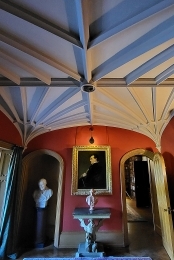
The mansion at Hughenden Manor was constructed near the end of the eighteenth century, and was heavily remodelled according to the tastes of the Disraeli family when they acquired it. The ground floor rooms are good examples of the gothic revival style. Some of the ceilings on this floor have fan-vaulted ceilings. We were lucky to have visited the place on a bright sunny day because even then, the rooms are pretty gloomy. On an overcast day, the place would seem quite melancholic. The dining room, which we saw at just before midday was depressingly dark, and made even worse by the presence of an enormous portrait of Queen Victoria that overlooks the round dining table. Disraeli (Benjamin) must have been a great ‘fan’ of Victoria because his bedroom on the first floor is filled with portraits of Victoria and her family, which the Royal Family gave him. The bedroom and other rooms on the first floor are far brighter, better illuminated through the windows, than those on the floor beneath, These first floor rooms are, luckily, not adorned with the ‘over-the-top’ gothic revival décor, which mars the ground floor’s appearance.
The mansion at Hughenden Manor is certainly not one of the most beautiful houses maintained by the National Trust, but the hilly grounds surrounding it are wonderful. When (if) we visit Hughenden again, we will miss out entering the house, and concentrate on enjoying the gardens and countryside around it.
March 1, 2025
It is amazing what can be created with Lego bricks and old buttons
THE PROVOCATIVE CHINESE artist Ai Weiwei was born in Beijing in 1957. He now works in places around the world including Beijing. In 2011, he was arrested in Beijing and held without charge for 81 days. At other times, he has been harassed by the Chinese state. Despite this and his overtly artistic criticism of the ruling regime of the People’s Republic of China and several periods of exile from that country, he now spends some time working in his studio in a house near Beijing. The rest of his time is spent working in various places including Cambridge (UK), Lisbon (Portugal), and Berlin (Germany). At the Lisson Gallery in Bell Street (near London’s Edgware Road stations), there is a small but wonderful exhibition of works by Ai Weiwei, which will continue until 15 March 2025.
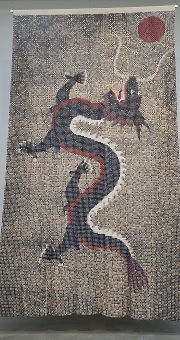
The exhibits on display at the Lisson Gallery demonstrate the incredibly inventive and imaginative nature of Ai Weiwei’s creations. Two of the works on display are rusted cast-iron sculptures. Two huge images, one in the style of Van Gogh and the other in the style of Gauguin, are made using many thousands of tiny toy (? Lego) bricks of different colours. From a distance these, and other large pictures made with the tiny bricks seem as if they are painted, but seen close-up it is obvious that the images are a complex mosaic of toy bricks.
Other exhibits also employ Lego bricks. These are not flattish creations like the ones mentioned above, but three-dimensional sculptures. In each case, the artist has taken an object (e.g., a rusting military helmet or a porcelain model of a lion) and partially enclosed it within a structure made of Lego bricks.
Buttons are extensively employed in other exhibits. Ai Weiwei sourced the buttons from the now closed A Brown and Co Buttons factory. The buttons, which are variously coloured, are used like the Lego bricks to produce mosaics depicting words and images. The buttons are sewn on to fabrics and in one case onto a ring of sandals.
Without doubt, each of Ai Weiwei’s creations are based on his interpretation of events historical and contemporary. However, although knowing the ideas behind his artworks adds to the understanding of the show, the exhibition at Lisson Gallery can be enjoyed without any knowledge of what was going through the artist’s head while he was creating the works.
February 28, 2025
Visiting the Open Wound at the Tate Modern in London
THE HUGE TURBINE Hall that forms the entrance and centrepiece of London’s Tate Modern is used for temporary exhibitions. Until 16 March 2025, the Turbine Hall is home to a somewhat weird but visually fascinating art installation, “Open Wound, created by Mire Lee, who was born in South Korea in 1988.
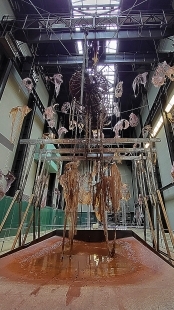
At first sight, it seems that discarded skins of various shapes and sizes are hanging from the ceiling. Standing on the floor beneath some of them is a tall tower that carries what looks like a piece of ageing industrial machinery suspended from an overhead crane. This rotates slowly while drops of liquid fall from it onto some of the skins and elongated sausage-like pieces of fabric before dropping into a pool on a large piece of stretched material. Set in the lofty, rather inhuman, Turbine Hall, this installation made me feel as if I were inside an enormous abattoir.
Apart from being intriguing to look at, I was not sure what to make of it. The Tate’s website noted:
“Lee believes ‘being moved is the strongest thing you can experience through art.’ Reflecting on our current historical moment, Open Wound conjures ‘the mood of a deserted construction site’, an atmosphere of ‘futility and melancholy, where something has started to wither.’ Despite this, the collective ‘skins’ of the living factory suggest an eerie solidarity. They mutate the Hall into an intimate space of ‘dream and distant memory’, in which such feelings can be shared.”
Well, having seen the work in the Turbine Hall, these words made sense. I am not sure that I would recommend people going out of their way to see this installation, but if you had other reasons to visit the Tate Modern, then do spend a few minutes looking at Mire Lee’s creation.
February 27, 2025
Visible but intangible works of art at London’s Tate Modern
SCULPTURE CAN BE APPRECIATED by enjoying the light reflected off it or passing through it, by touch, and sometimes by sounds it makes. Today, at London’s Tate Modern gallery, I saw an exhibition of sculpture that can be seen, but cannot be touched or even heard. The exhibits were beams of light projected onto screens through a room filled with the sort of smoke used in theatres to create haziness. All these exhibits were created by the British artist Anthony McCall, who was born in 1946.
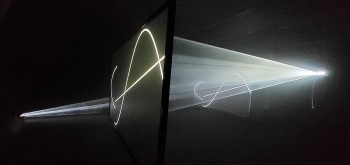
The projected light creates often changing patterns on broad screens. What makes the exhibits really exciting is that the slowly moving smoky haze in the room allows the viewer to see the paths taken by the projected light through space. These three-dimensional envelopes of light produce interesting sculptural forms, but unlike most sculptures, the viewer can move through them unimpeded. And while moving through these space-filling light formations, the viewer modifies their shapes and what is projected onto the screens. The results are both intriguing and beautiful, apart from being quite unusual. Words cannot adequately describe what we saw at this show. You need to experience it for yourself to enjoy this intangible but intensely visual sculptural show, which is continuing until 27 April 2025.
February 26, 2025
The wash room at Milton Keynes Gallery
February 25, 2025
The versatility of a female artist seen at an exhibition in Milton Keynes
IN 1961 MY MOTHER, Helen Yamey (1920-1980) was invited to exhibit some of her sculptures in the prestigious London Group (‘LG’) annual exhibition. The LG, founded in 1913, staged artists whose work was good, but too adventurous or experimental for the Royal Academy. It was the first group in Britain to actively promote Modernism in British art. Her warks were exhibited alongside those of now famous artists such as Frank Bowling, David Hockney, Howard Hodgkin, Francis Newton Souza, Eileen Agar, Frank Auerbach, Duncan Grant, LS Lowry, Julian Trevelyan, and Vanessa Bell. Because of the last name mentioned, it was with great interest to me that we visited the exhibition of works by Vanessa Bell which was being held at the Milton Keynes Gallery until 23 February 2025.
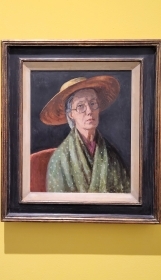
Vanessa Bell (1879-1961), a niece of the famous Victorian photographer Julia Margaret Cameron, was in the final year of her life when the above-mentioned LG exhibition was held. It would be interesting to know whether she met my mother at this show. There is a small chance that this meeting might have happened because the LG exhibition was held in March 1961 and Bell died (of a brief illness) in early April that year.
The exhibition at Milton Keynes was well-curated and beautifully laid-out. In a series of interconnecting rooms, the visitor was able to follow Bell’s creative output from the beginning of the twentieth century until near the end of her life. The show demonstrates Bell’s great versatility as an artist. One of the earliest of her paintings is a portrait of her father, Sir Leslie Stephen. It is an extremely competent painting in the style of the Old Masters. Soon after painting this, her style changed because of being influenced by the styles of early twentieth century European avant-garde artists. Her paintings began to acquire a tendency towards abstraction, but with a few exceptions on display at the exhibition, they never ceased to be even slightly figurative. In 1912, she exhibited her works in the Second Post Impressionist Exhibition alongside those of, for example, Matisse, Braque, and Picasso. A few of the paintings we saw reminded us of Modigliani.
Shortly before the outbreak of WW1, Vanessa moved out to Charleston in Sussex along with her husband Clive Bell, Duncan Grant, and Duncan’s lover David Garnett. She hired a cottage so that Duncan and David could work as farm labourers and thus avoid being conscripted into the military. After WW1, when the more adventurous styles of what was then ‘modern art’ went out of fashion in the English art market, Bell’s paintings reverted to being more figurative in style. The exhibition includes many examples of art which were created collaboratively by Vanessa Bell and Duncan Grant. These works include furnishings (many for decorating the house in Charleston) and ceramic works, including a series of 50 plates, each with a portrait of a famous woman. These were commissioned by the art historian Kenneth Clark and were all on display in the exhibition. Bell also designed many book covers, notably for her sister, the author Virginia Woolf,
Bell’s later paintings were all beautifully executed, many of them being depictions of domestic scenes. Although my favourites were her earlier paintings that tended towards abstraction, I was also very much taken by some of her later paintings executed in the 1950s. Having declared that, I must say that I am very pleased that I managed to see the wonderful exhibition at Milton Keynes in the ‘nick of time’.
Returning to my mother, whose works were exhibited in the same show as Vanessa Bell’s in 1961, you can read all about her and her activities at the forefront of British sculpture in the 1950s and early 1960s in my book “Remembering Helen: My Mother the Artist”, which is available from Amazon, e.g.:https://www.amazon.co.uk/REMEMBERING-HELEN-MY-MOTHER-ARTIST/dp/B0DKCZ7J7X/
February 24, 2025
Overcharging by Uber taxi cabs in Chennai
WHENEVER WE HAVE HIRED Uber cabs in Bangalore, Bombay, Calcutta, and Hyderabad, we have always paid the amount quoted on the Uber app when making the booking: no more and no less. During a recent visit to Chennai (Madras) in January 2025, we ordered several Uber cabs, and each time experienced the same thing.
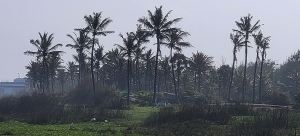
The first Uber cab we ordered arrived, and the driver asked us how much we had been quoted. When we told him, he said he would take us only if we paid an amount he mentioned, which was greatly in excess of the fare quoted on the app. On subsequent occasions, we ordered Uber cabs using the app and each time the driver telephoned us before he arrived. Each driver wanted to know the price of the fare on the app. And each time we told the driver the amount, he replied that he would only pick us up if we agreed to pay the higher fare he quoted. We were most surprised by this, but a friend in Chennai seemed to think that there was nothing unusual about what we were experiencing.
I suppose the Uber drivers in Chennai are charging a surcharge to cover what the Uber company deducts from them as a commission.

